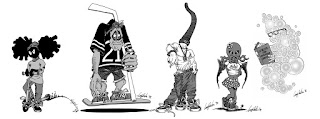One
thing that I’ve learned over a lifetime of roleplaying is that the rules are
far less important than the story being told. Gamers tend to fall into two
heaps: those who feel comfortable within a completely mapped-out mathematically-modelled
reality, and those who prefer a looser, story-based narrative wherein the
choices of the players and the referee drive the action along. I much prefer
the latter style, although it has issues of trust and mutual understanding to
overcome, as opposed to the “rules-lawyering” of the first model which, to me,
smacks of insecurity and competitiveness. Some people want everything on a
level playing field, all the buttons and switches equally available to all participants,
while others are there for the colour and the mood.
Over
time I have tried games that support both styles of play. Most superhero
roleplaying is of the number-crunching variety – “Champions” and the like – as is anything to do with Mecha, or systems
derived from the Palladium games company (“Rifts”
– the bestselling roleplaying game that no-one ever plays). The “Dungeons & Dragons” re-boot – 3rd
Ed. – was championed by rules lawyers who tried to kill the storytelling aspect
of the old standard by pinning everything down to dice rolls and complex
charts. The effort underscored to me that it doesn’t matter what the rules are,
it’s what you do with the genre and the story you’re trying to tell. Rules are
props; you use them or toss them as the situation demands. I’ve introduced many
people to “Dungeons & Dragons”
and I’ve always used AD&D – it’s what I learned how to roleplay using and
it’s easy, light and fun.
I’ve
found that the best games are ones where the rules – either implicitly or
explicitly – support their genre. Top of the heap for me (you may be surprised
to learn) is “Pendragon”. The rules
for this classic game are simple, elegant, and inextricably tied to what it
means to be a knight in King Arthur’s court. The most rule-intensive part of
the process is character-generation, which often puts new players off; after
that, players and referee conduct themselves as questing knights and their
character choices directly influence the way the rules produce outcomes. It’s a
game where the story moves along on the strength of dice rolls and those rolls
are influenced directly by the players’ tactics and decisions. The experience,
at the end of the day, is that you’re telling the story of a knight, not
rolling dice around the table.
The
key element here is mood. If the game can be played such that the mechanics don’t
affect the atmosphere of the story, then it’s a success. “Deadlands” was a game that completely missed this point. There was
so much to enjoy about the genre of this game – its environment and the
possibilities of story-telling – but when you got down to it, all the cards and
dice and coloured paper clips pushed the story to one side in favour of the
number-crunching. I wrote several scenarios for this system for roleplaying
conventions and the first thing I chucked was the rule system: it was just too
clunky.
A
little-known classic that crossed my radar was “Feng Shui”, a game about 80s action movies. Again, the simple rule
system sits nicely in the background waiting only for moments of resolution to
discreetly raise its head; otherwise, playing this game is like running through
some weird blend of chop-socky, steroidal, gun-toting B-grade flicks with a
synth-pop soundtrack (watch “Kung Fury”
and you’ll know what I mean!). It’s not a game to run a campaign with; rather,
it’s beer and skittles roleplaying, and it’s heaps of fun.
The
final game on my list is “Toon”, or
rather, the sitcom version it generated entitled “Teenagers From Outer Space”. In this game you play alien teenagers
newly arrived on Earth and trying to integrate at a typical American TV high
school. All of the standard tropes come into play here – cheerleaders and
quarterbacks, nerds and slackers – with the extra silliness of alien
superpowers thrown in. Once more the rules are light and don’t detract from the
story – this is a game intended to make you laugh, so not breaking the mood was
high on the designers’ ‘to do’ list. I like this game so much in fact, that I
wrote a convention module using it, about the high-school-aged offspring of the
Old Ones of the Cthulhu Mythos. Here’s what I came up with:
All
this kind of leads me back to my main point: if you let the rules get in the
way, you stifle your creativity and you lose the point of what you’re trying to
do. Of course, my favourite game of all is “Call
of Cthulhu” (goes without saying) because the BRP system is light enough and
flexible enough to cover everything without ruining the storytelling. I’m
hearing a lot of quibbling about the 7th Edition of the game and I’m
wondering if the new rules are simply re-creating the debacle that was D&D
3rd Ed.? If there’s no mood, there’s no Mythos; if you need to drop
everything to roll dice in order to orchestrate a car chase, then there’s
something very wrong going on here. I’m not against taking out the old vehicle
and slapping on a new coat of paint, but if it’s not broken, why try to fix it?
I’m sure many people will be asking themselves this question before shelling
out their cash for a possibly inferior product...

No comments:
Post a Comment